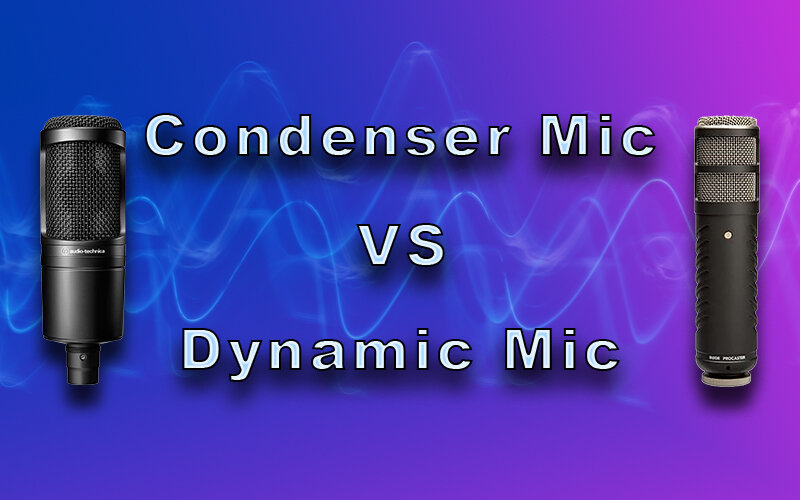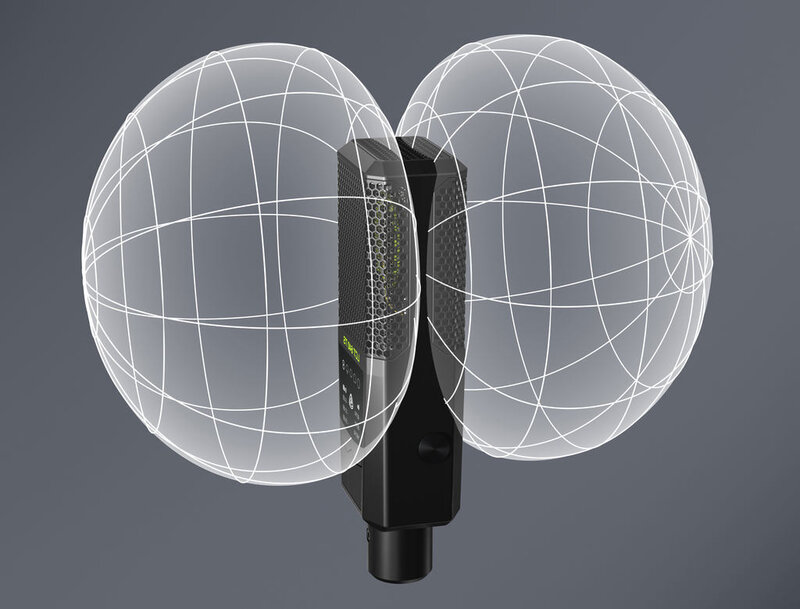Finding the right microphone that will be useful in your streaming experience, especially if you have no idea what are the specifications of condenser or dynamic microphones.
These two tend to differ a lot in all aspects, but they also tend to have some similar specs that can make a choice quite tough.
If you want o find out more about these microphones and find the right fit for yourself, then read our guide carefully!
Table of Contents
Condenser Mic vs Dynamic Mic – Ultimate Comparison

1. Active or Passive
Active microphones are those that require a lot of power supply in order to work, and in this case, those are condenser microphones.
They are always active, unlike dynamic microphones that don’t need any sort of power in order to work perfectly.
Active microphones need several components in order to work properly, and you will need to learn how to handle vacuum tubes, capsules, printed circuit boards, impedance converters, and many other things if you want to use them.
On the other hand, dynamic mics are much easier to handle, and since they work on electromagnetic induction, you won’t need to connect them to any type of phantom power.
The best dynamic microphone is those that are USB powered, and they are also the easiest to use because all you will need to do is connect them with your device and charge them when it is needed.
Most of the dynamic microphones on the market these days are USB powered, and they tend to offer the best sound quality, even though that wasn’t the case before.
2. Transducer Principle
This is the biggest difference between dynamic and condenser microphones and the easiest way to differentiate between these two.
The main difference is that dynamic mics are able to convert the energy only through electromagnetic inductions, while condenser mics are based on electrostatic principles.
Dynamic mics are able to work when the conductor goes through the change of a magnetic field, and this process is necessary for the mic to create a frequency response.
Some people tend to call them moving-coil microphones since they need to have a conducted coil attached to themselves all the time; otherwise, the sound waves won’t hit it.
The moving coil and the diaphragm of the mic are always in the center of the magnetic field that will create a cylindrical cutaway.
When the diaphragm is moving left and right, it leads to a higher voltage across the coil that then produces sound waves from your microphone.
On the other hand, we have condenser mics that are electrostatic and that work as a capacitor that is completely parallel.
Its electrical leads are connected both to the front and backplate, and they are 100% movable but need to be fixed in order to send the sound waves.
You can fix it with phantom power or an external power supply, and basically, any of the similar options should work fine on it.
By moving the capacitor around but keeping it connected to the plates, a proportional voltage will be created, and you will get the right mic signal.
3. Frequency Response
Many people tend to choose a condenser mic because it has a perfectly flat frequency response, and you can even create extended frequencies.
They are able to recreate the sound from real-life perfectly, and when they convert sound waves, they make sure everything stays as realistic as possible.
For that reason, people who create podcasts or connect with their community through live streams use this type of mics because they know when the sound waves hit their audience, everything will sound the same way as it does for them.
However, if you are moving around a lot and you are not paying attention to the audio interface for streaming, your audio quality may not be the best, and it can even be harsh at some moments, so make sure you avoid loud sounds or sudden changes in your environment.
I would recommend you to get small-diaphragm condensers because they tend to produce more delicate sounds.
A dynamic mic has fairly limited performance, and its frequency response tends to be very colored, so if you want to use it for recording vocals or complex sounds, then you probably should choose a condenser one or get a specific mic that is made to record vocals.
Every dynamic mic I have ever used performed quite badly, and when it came to louder sounds, the recording tended to break the moment it reached the higher pitches, so I definitely don’t recommend it, especially if you are earning from this.
However, if you are using it just to live stream your games and you don’t need any fantastic or detailed sound, it will do the job well.
4. Transient Response
Even though most people have no idea what it is, this is one of the most important features of every microphone.
A good microphone needs to have a good transient response; otherwise, the live sound won’t sound too natural, and you won’t be able to transfer the sound waves in real-time.
Condenser mics always have a good one, and that is because their diaphragm moves quickly and it is very light, which makes it react to every single sound wave in its surroundings.
This makes it a great choice for people filming podcasts or vocals, and it eliminates the self-noise.
Those with a smaller diaphragm are the best ones, and they will provide you with perfect higher frequencies.
However, a dynamic mic will have a slow transient response, and it won’t be that accurate, which can especially create problems with high-frequency sounds.
This recording device tends to have a heavy and thick diaphragm that are inert and don’t react when it is needed.
Their snare drum is fine, especially if they have a large-diaphragm condenser, but they will not be able to handle loud sounds well, and your vocal mic signal may sound way too dramatic.
The oscillations are also relatively high, and there is not much you can do regarding that, so if this is important to you, I would always choose a condenser mic.
5. Polar Patterns
Polar patterns are the key to acoustic energy and the sound quality so you will need dynamic and condenser mics that are good at handling this.
A condenser mic can have any polar pattern, and it can have one or two diaphragms at the same time.

Manufacturers tend to mix different amplitudes in one condenser microphone and create multiple polar patterns.
Most of the condenser mics you will find on the market these days have several polar patterns, which is the reason why they are able to replicate the loud sound and high frequencies so well.
On the other hand, dynamic microphones usually have just one polar pattern, and their structure tends to be quite simple.
Depending on the capsule of the dynamic microphone, the voice coil can have an omnidirectional or unidirectional pattern.
Since one side of the diaphragm needs to have a fixed structure and magnetic coil, it is impossible to have several polar patterns at the same time.
For that reason, I am always a much bigger fan of condenser mics.
6. Durability
When you are thinking between dynamic and condenser microphones, you are thinking about which one of these devices is more enduring.
Even though condenser mics tend to be a lot more popular, dynamic microphones can endure a lot more, and they are practically unbreakable, no matter the brand or the price range.
Most condenser microphones are long-lasting too, but since their diaphragm moves around a lot and is quite sensitive, I wouldn’t recommend you to be too harsh on it.
They have vacuum tubes, so they tend to be very fragile, and if one of these tubes gets broken, your sound will not be good at all.
Dynamic microphones have a more rigid structure, and they are pretty stiff because of the magnetic field, so you won’t have to worry that they will break easily.
They also don’t have any problematic parts, so you don’t have to worry that something inside your dynamic microphones will get broken and that you won’t spot it.
7. Sound Pressure Levels
What is the maximum sound pressure level of your microphone determines whether the mic signal will get distorted or not.
All condenser mics have a maximum sound pressure level, referring to the highest point where the mic signal will start distorting.
Dynamic microphones don’t have high sound pressure levels, if they have them at all, so they are not a safe bet.
The diaphragm of a dynamic mic can’t get overloaded, and these sound pressure levels are pretty impractical, no matter what you may be using the dynamic mics for.
8. Self Noise
All condenser mics have a self-noise, while dynamic microphones do not.
All active condenser microphones have different components that will add self-noise to the mic signal.
However, even though all microphones tend to have some sort of noise floor, this is definitely not enough on dynamic microphones because it doesn’t have active components that will add the noise to the mic signal.
9. Sensitivity
The sensitivity shows a mic’s signal level under a certain sound pressure level.
All condenser mics are extremely sensitive, and they are the right choice for professionals or those working with acoustic guitars or a drum kit.
Their ribbon microphones make them work great as a room mic, and they can produce a bass drum ideally.
However, even the USB microphones that are dynamic mics will be sensitive to a certain extent, but they won’t have too high output levels.
However, if you are choosing between dynamic vs condenser mic, I would say there is not too big of a difference, except if you are using it for music purposes and you need your acoustic guitars sound, bass drum, and ribbon mics to sound like a studio recording, then a condenser microphone is a much better investment.
Acoustic instruments work well only with a condenser mic because it is the only device that can handle higher frequencies well.
10. Price
Last but not least, the price is one of the most important things people are looking at when deciding between dynamic and condenser mics.
If you are still dwelling whether a dynamic vs condenser mic will win in this battle, I believe you will always opt for a dynamic microphone.

Dynamic microphones tend to start at 10 dollars, and you can find great electrical energy microphones for less than 30 dollars.
They may require phantom power, but they will pay off in the future because there is no way they will cost you more than 100 dollars for years of using it.
On the other hand, you can get a large-diaphragm condenser for 40 to 50 dollars, but those that are in the lower price range are usually not good enough, and you will need to splurge on a condenser microphone that is over 100 dollars.
You will also need to invest in a condenser microphone capsule which is not cheap.
If you are not a professional streamer or podcaster, I would recommend you to get a dynamic microphone, but if you are serious about your future in the online community, then a condenser mic is an investment that will pay off in the future for sure.
Which One Is The Right Option For Streamers?
A dynamic microphone is always my recommendation to all streamers because it is a lot cheaper and still provides you with good sound quality.
The quality of th sound may not be absolutely perfect, but it will definitely be good enough for live streams, and your viewers will be able to keep up with you.
Also, you won’t need to invest in new components and things like capsules or vacuum tubes which will save you both a lot of time and money.
Dynamic microphones are a lot easier to handle and they will do their job perfectly even if you don’t use any additional programs or settings that will upgrade them.
